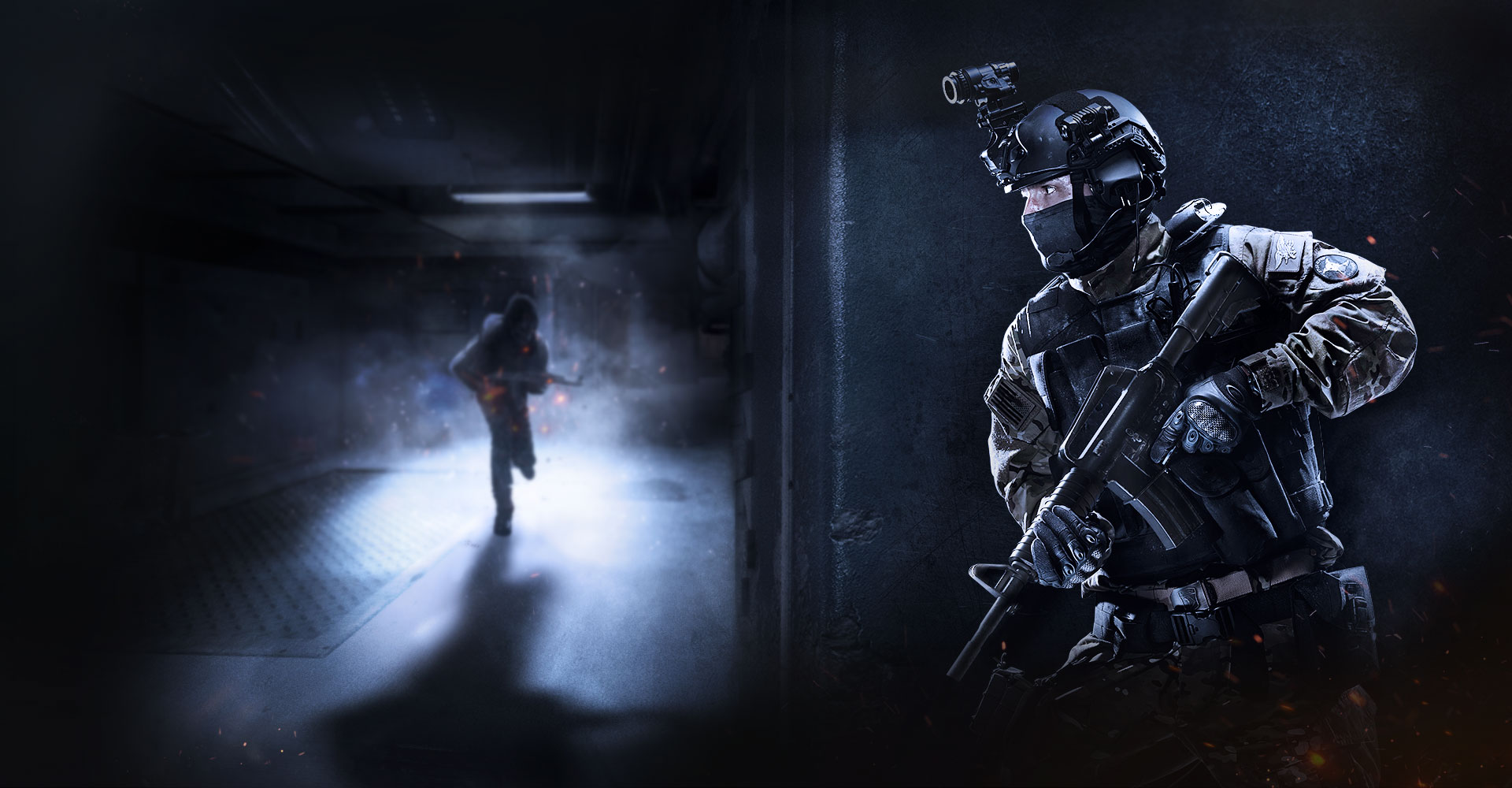

Trying to find the best CS:GO settings to improve your gaming experience can be a difficult challenge, but this definitive guide will detail all the settings you need to know to be well on your way to become a CS:GO pro.
Top 10 tips for improved CS:GO performance
The best CS:GO settings will always depend on the player’s personal preferences and hardware setup. However, there are a few general tips that can help players optimize their settings for the best gameplay experience:
- Enable vertical sync (VSync): This setting helps to reduce screen tearing, which can occur when the frame rate of the game exceeds the refresh rate of the monitor.
- Set the refresh rate to the highest available: A higher refresh rate will result in a smoother gameplay experience, especially in fast-paced games like CS:GO.
- Enable multi-core rendering: This setting will take advantage of multiple CPU cores, which can help to improve performance on multi-core processors.
- Adjust the resolution: Setting the resolution to the native resolution of the monitor will result in the best image quality, but may impact performance. Players can experiment with lower resolutions to find a balance between image quality and performance.
- Adjust the graphics settings: Players can adjust the graphics settings of the game to find a balance between image quality and performance. Some settings, such as texture quality and shadow quality, will have a larger impact on performance than others.
- Adjust the mouse sensitivity: Players can adjust the sensitivity of their mouse to find a comfortable and accurate setting. Sensitivity is a personal preference, so players should experiment with different settings to find what works best for them.
- Disable mouse acceleration: This setting will cause the mouse to move faster as it is moved further across the mouse-pad, which can seriously hinder the accuracy when aiming.
- Enable raw input: This setting will bypass the operating system’s mouse handling and directly use the raw input from the mouse. This can help to improve accuracy, but may take some getting used to.
- Adjust the crosshair: Players can adjust the appearance and behaviour of their crosshair to suit their preferences. Some players prefer a small, static crosshair, while others prefer a larger, dynamic crosshair that changes size based on movement.
- Experiment with different configurations: Every player is different, and what works for one player may not work for another.
How to enable Console in CS:GO
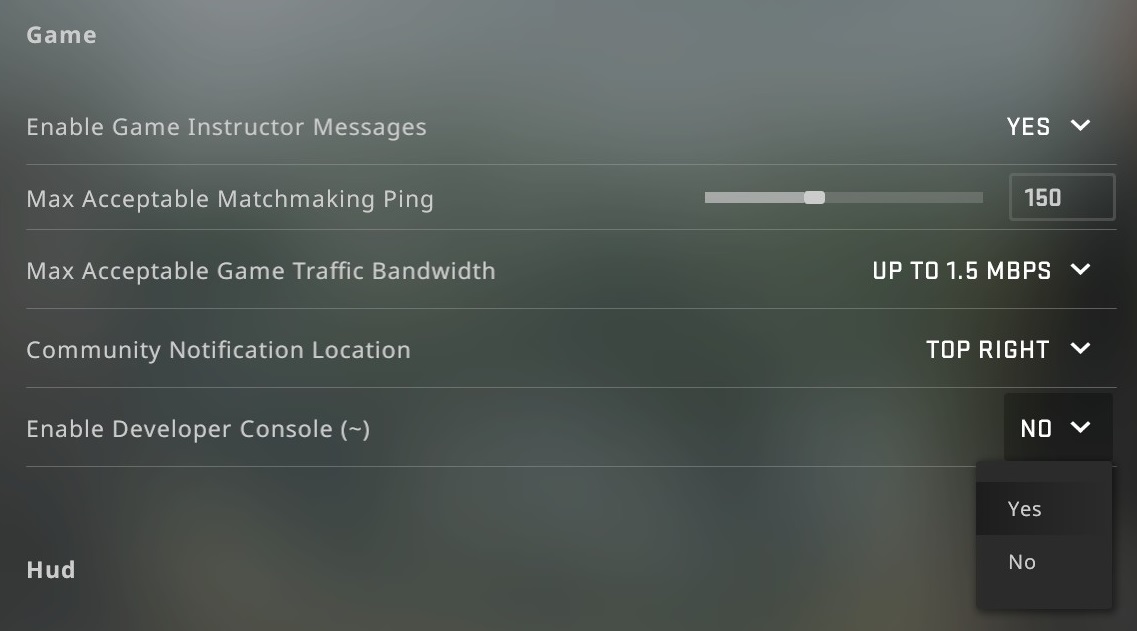
To open the developer console in CS:GO:
- Launch CS:GO and open the settings menu
- Select the “Game Settings” tab
- Set the “Enable Developer Console” option to “Yes”
By default the developer console can be accessed by pressing the ` key at the top left of your keyboard just below the Esc key.
Resolution and Aspect Ratio
The resolution and aspect ratio you use is largely down to personal preference. Whilst the game is designed with an aspect ratio of 16:9 in mind, it can support other aspect ratios such as 4:3, 16:10 and 5:4 to name a few.
What aspect ratio do most pro CS:GO players use?
The majority of pro CS:GO players use an aspect ratio of 4:3. The next most common aspect ratio is 16:9, the typical aspect ratio of most modern monitors.
When using an aspect ratio of 4:3 most professional players use a stretched resolution as opposed to having black bars down each side of their display. This results in the player/character models and other objects appearing wider than normal. As a consequence of this, players appear to move slightly faster when jiggle peaking or strafing.
What resolution do most pro CS:GO players use?
The majority of pro CS:GO players use a resolution of 1280×960. This is often paired with an aspect ratio of 4:3. The next most common resolution is 1024×768.
For players using an aspect ratio of 16:9, the most common resolution is 1080p Full HD at 1920×1080.
Grenade and Molotov Visibility
When grenades and molotovs are detonated they produce a thick black smoke which obscures the players vision. The effects of this smoke can be reduced by changing two settings within the video options.
Set Effect Detail to High and Shader Detail to Very High.
Note that changing these settings to the maximum quality will negatively impact your frame rate which may cause issues for players who use older graphic cards.
Audio Settings
Audio Output
The audio output configuration should be either Stereo Speakers or Stereo Headphones. Playing with Quad Surround Sound or 5.1 Surround Sound can cause significant audio issues in relation to the direction of sounds in-game due to conflicts between the audio drivers and the game. As a result, a player may hear the sound of steps coming from their left when in-fact the steps are coming from their right (and vice versa).
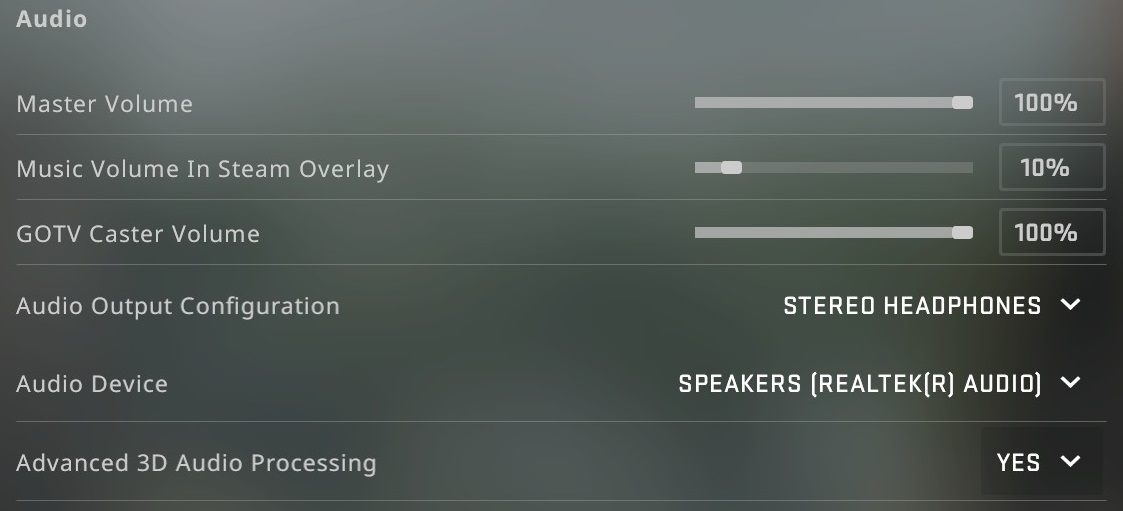
If your headset supports 3D audio or any other surround sound settings then experiment with these to find the best fit for you. If your headset does not support these additional settings then consider enabling Advanced 3D Audio Processing within the audio settings of CS:GO.
Ten Second Warning
Whilst there is much debate within the CS:GO community as to whether the ten second warning sound should be enabled or silenced, we still recommend at least having the setting on low volume to provide an auditory warning for the bomb timer whilst not overlapping the other sounds of players or gun-fire during a clutch situation.
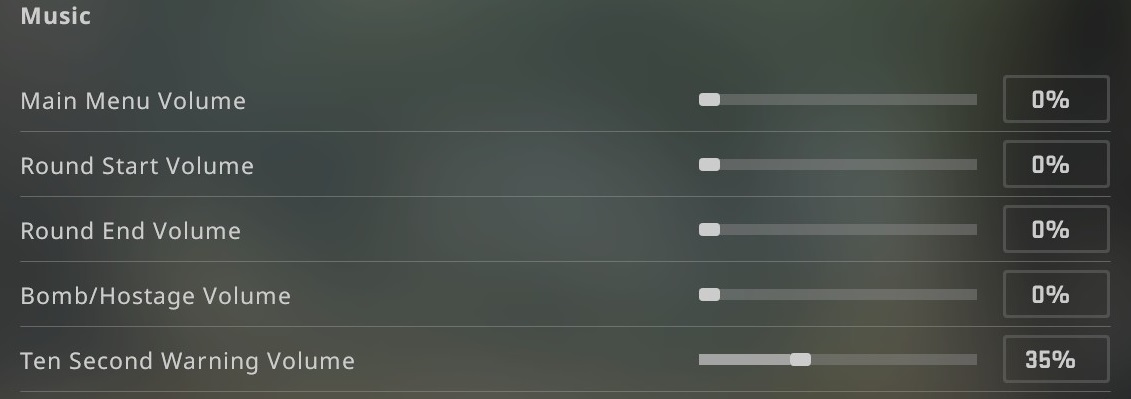
It is worth noting that the ten second warning is not precisely 10 seconds, however it should be sufficient warning to any CT player who does not have a defuse kit to abandon the bombsite.
Game Settings
Show Team Positions in HUD
We highly suggest setting the Show Team Positions in HUD option to “Show Location and Equipment” as this will allow you to see the weapons, grenades and other utility that your teammates are carrying. This is particularly useful during the buy time at the beginning of a round to determine whether any of your teammates need to be dropped a weapon.
This setting also acts as a X-ray feature enabling you to see your teammates through walls to determine their position on the map without having to always refer to the radar.
Radar / Minimap
The radar, or more commonly known as the “minimap” is the small map that appears at the top left of your screen by default.
To alternate between radar zoom levels during a match of CS:GO, create the following keybind:
bind "b" "cl_radar_scale 1.0 0.4"
Crosshair
Your crosshair in CS:GO is almost entirely personal preference, though there are a few common characteristics that almost all players use.
Most crosshairs are static, with a dot-less hollow centre and often appear in green, yellow or blue.
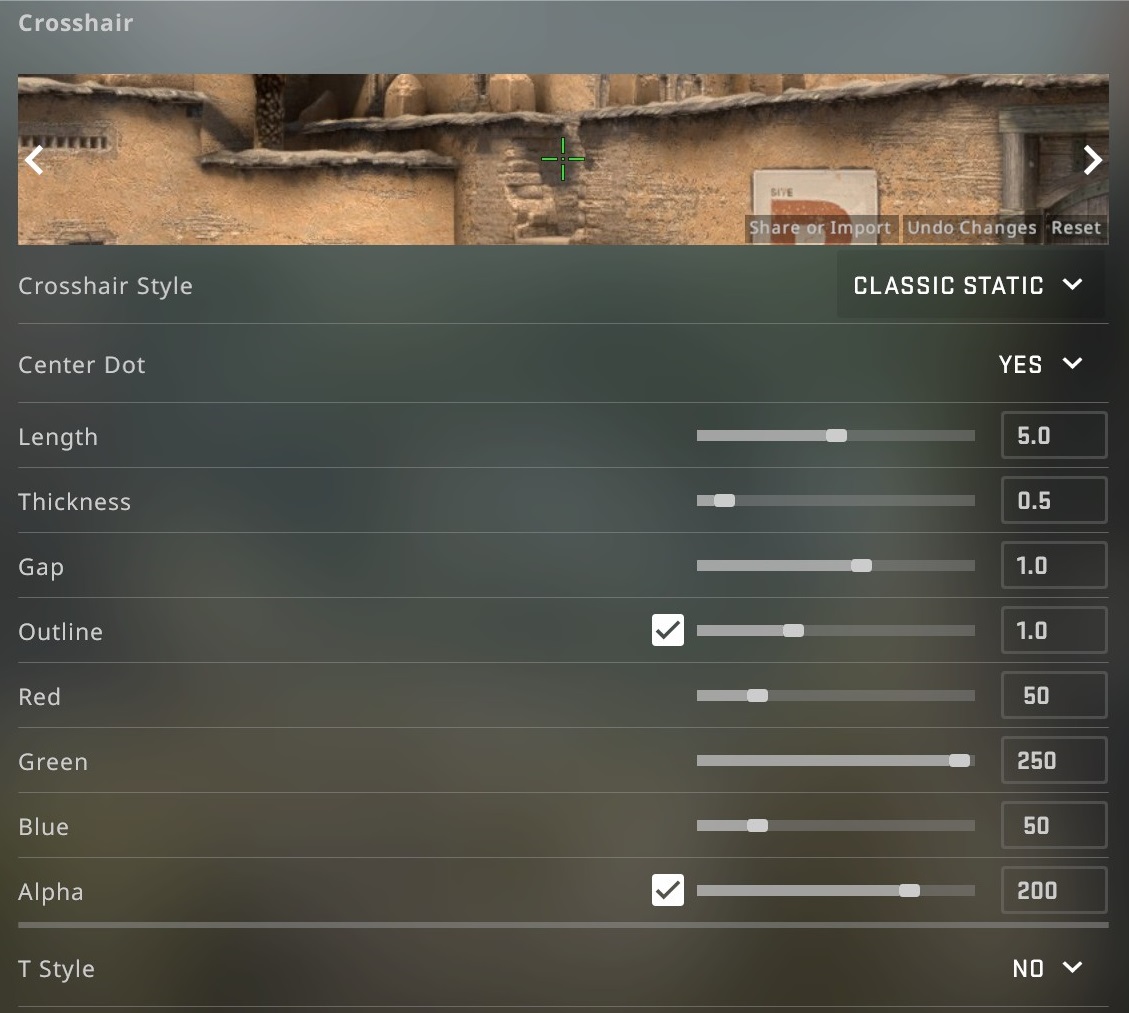
The crosshair can be customised in multiple ways via the in-game settings menu. Alternatively, a number of fan-made custom CS:GO maps exist in the Steam Community Workshop that enable you to experiment with the crosshairs used by professional players to find the perfect fit for you.
Example Crosshairs
If the static crosshair isn’t for you, then try some of the alternative crosshairs designs:
- The default crosshair (cl_crosshair_default_style 1) – This is a simple crosshair that is easy to see and works well for most players.
- The classic crosshair (cl_crosshair_style 4) – This is a classic crosshair that has been a popular choice for many years. It has a larger dot in the middle, which can be helpful for aiming.
- The dynamic crosshair (cl_crosshair_style 5) – This crosshair changes size based on your movement and accuracy, making it easier to track enemies.
- The dot crosshair (cl_crosshair_style 0) – This crosshair is a small dot that can be very precise, but may be harder to see in some situations.
Viewmodel
The most commonly used viewmodel is the default viewmodel. Adjusting the viewmodel can help with regaining more screen real-estate for a less obtrusive field-of-view.
It is recommended to create a key-bind for alternating your weapon from the left or right-side of the display when peaking angles.
Frames Per Second (FPS)
If you are looking to improve your FPS in CS:GO then consider changing the following:
Disabling G-sync and V-sync
Reducing model/texture detail quality
Reducing global shadow quality
Enabling multicore rendering
If possible it is advised not to reduce the quality of global shadows as this can negatively impact you in being unable to see the shadows cast by enemy players from a long distance.
Launch Options
We recommend setting your launch options to the following:
-tickrate 128 +fps_max 0 -novid -nojoy
-novidremoves the short video that plays when booting up CS:GO.-tickrate 128sets the default tick-rate for local and third party servers to 128. Note that official CS:GO matchmaking servers are 64-tick and this cannot be changed.+fps_max 0removes the frame rate limit.-nojoyremoves joystick controller support which may improve FPS marginally.
To update your launch options go to your Steam Library, right click on CS:GO and click “Properties”. Click on the button reading “Set Launch Options”, paste in the launch options above and click “OK”.
Hardware Requirements
Steam System Requirements
The minimum requirements as defined on the official CS:GO store page on Steam is as follows:
| Specification | Windows | macOS | Linux & SteamOS |
|---|---|---|---|
| Operating System (OS) | Windows® 7/Vista/XP | MacOS X 10.11 (El Capitan) or later | Ubuntu 12.04 |
| Processor (CPU) | Intel® Core™ 2 Duo E6600 or AMD Phenom™ X3 8750 processor or better | Intel® Core™ Duo Processor (2GHz or better) | 64-bit Dual core from Intel or AMD at 2.8 GHz |
| Memory (RAM) | 2 GB RAM | 2 GB RAM | 4 GB RAM |
| Graphics (GPU) | Video card must be 256 MB or more and should be a DirectX 9-compatible with support for Pixel Shader 3.0 | ATI Radeon HD 2400 or better / NVIDIA 8600M or better | NVIDIA GeForce 8600/9600GT, ATI/AMD Radeon HD2600/3600 (Graphic Drivers: NVIDIA 310, AMD 12.11), OpenGL 2.1 |
| Storage | 15 GB available space | 15 GB available space | 15 GB available space |
However, the above requirements are long out of date, with the significant graphic improvements and additional features such as game-modes that now require hardware specifications much better than what is currently suggested by Valve.
For example, the storage space required to install CS:GO is much greater than 15 GB. A clean install of CS:GO on Windows 10/11 requires just over 30 GB of available space. The amount of storage space required will grow further if custom maps or game-modes are downloaded from the Steam Community Workshop.